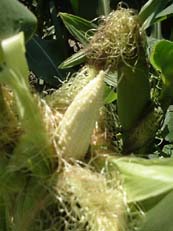|
So
far, more than 600,000 Web surfers from around the world have
visited Iowa Farmer Todayís CornCam site. One could find the field
in rural Prairieburg, which is in northeast Iowa. But why drive
there when all a connected person has to do is click here: http://www.iowafarmer.com/corncam/corn.html
Those
of you who are not so intimately involved with corn production might
be questioning the importance of watching the corn grow. Think of it
this way: Those thousands of cornfields in Logan County are not
really just fields of corn. Rather, they are industrial parks. And,
each corn plant is its own individual factory!

[Al
Wolf is a giant of a man, but this corn is even bigger at
approximately 9 feet.]
As
a veteran corn scouter, I canít say that Iíve ever actually seen
a particular corn plant rising up inch by inch. But one thing is for
sure, when environmental conditions are right, corn can do a lot of
growing in a 24-hour period.

The
CornCam site actually documents how many inches their corn has grown
in a dayís time. Al Wolf, manager of Lincoln Ag Center and a top
Garst seed corn dealer, thinks that you can see it grow. "Thereís
a lot of tall corn this year," comments Wolf. "I really
didnít think that it would get that way since it was planted so
early."
Things
have just fallen into place this year. Central Illinois farmers were
bracing for a drought year and have been pleasantly surprised with
ample rainfall.
The
key to a successful corn crop is to have plenty of water and
sunlight during the critical developmental stages. Corn grows best
in 85-degree temperatures. High temps in the 90s cause the corn
plant to shut down. It is during these intense growth and stress
periods that water needs are the greatest. Approximately 5,000
gallons of water is needed to produce a single bushel of corn.

Average
yields around Logan County are usually in the 140- to 200-bushel
range, depending on soil type and growing conditions throughout the
year. Yet todayís hybrid corn seed is said to have a yield
potential of greater than 500 bushels to the acre. You see, from the
day the corn is planted, a multitude of stress factors can reduce
the yield from its highest potential to the amount actually
harvested. Those stress factors can include drought, heavy rains,
cold weather in April and May, scorching hot weather in July, below
and above ground insects, too many weeds, too few nutrients in the
soil, and so on. As these stress factors compound, yield potential
plummets.
(To
top of second column)
|

Agronomic
specialists at the University of Illinois contend that the optimal
window for planting corn in Central Illinois is between April 15 and
May 1. Planting dates later than May 1 will diminish the yield
potential by five percent per week.
Fortunately
for Logan County farmers, 2000 corn yields could be much higher than
we have seen in several years. Virtually everyone had their corn
planted by May 1. The early drought conditions actually proved
helpful as farmers were able to take their time planting and
eliminate any compaction issues caused by "mudding in"
corn. Plus, corn was able to start the pollination process around
the last week of June prior to all the scorching temperatures
normally experienced in July. There has been very little insect
pressure this year, and the rains have been kicking in at just the
right time. Now, as long as the pounding wind and rains of last
August stay away, this yearís Logan County corn crop could be one
well worth remembering.

[This
ear of corn in the Garst plot next to Lincoln Ag Center is in the
Blister stage. This
means that it has been pollinated and that the kernels are starting
to grow.]
"We
need about one more good rain during fair week to make the corn
crop," reminds Wolf.
You
wonít be seeing the 2000 Logan County corn crop grow any taller.
Now all the corn plantís energy is being utilized in producing
big, healthy ears. Most of the corn has been pollinated and is in
the blister stage. Yet to follow are the milk, soft dough, full dent
and physiological maturity stages, with each stage lasting from 8 to
12 days. During this time, nutrients still in the soil and elsewhere
in the plant will be migrating to the kernel. Harvest will begin
when the stalk looks as if it is dead and the moisture content of
the corn is around 15 percent.

The
corn plant is fascinating indeed. Log on to the CornCam site to
watch the corn grow, and visit the many links to better understand
all the incredible things happening in the fields all around you.
http://www.iowafarmer.com/corncam/corn.html
[Marty
Ahrends]
Editorís
note: Send in your favorite corn recipes to ldneditor@lincolndailynews.com.
We'll post them with other favorite summertime recipes in the new
Home and Family section.
|

